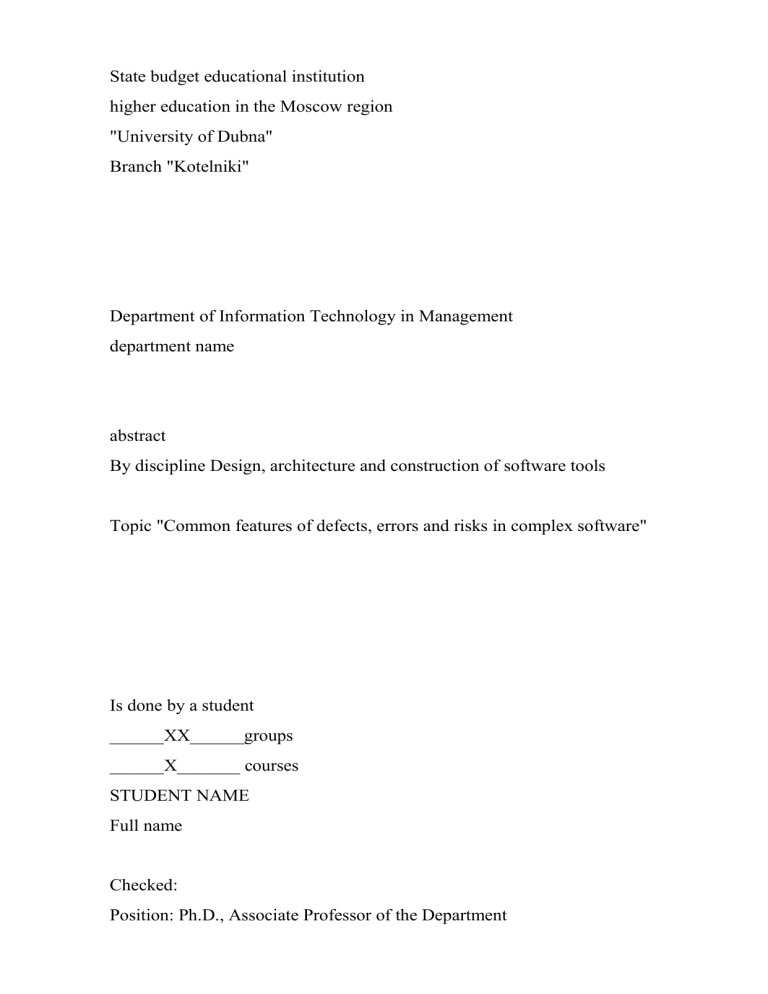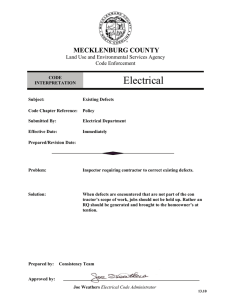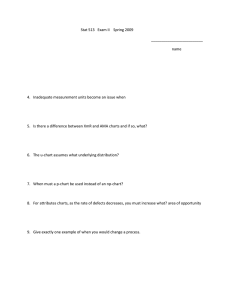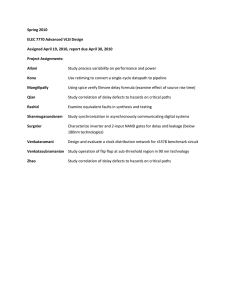
State budget educational institution higher education in the Moscow region "University of Dubna" Branch "Kotelniki" Department of Information Technology in Management department name abstract By discipline Design, architecture and construction of software tools Topic "Common features of defects, errors and risks in complex software" Is done by a student ______XX______groups ______X_______ courses STUDENT NAME Full name Checked: Position: Ph.D., Associate Professor of the Department Name: Podlevsky A.P. Grade ______________ Date November 2, 2021 Signature ________________ Kotelniki -2021 CONTENT INTRODUCTION 3 CHAPTER 1. COMMON FEATURES OF DEFECTS, ERRORS AND RISKS IN COMPLEX SOFTWARE 4 1.1 The concept of a program error 5 1.2 Error levels, types and sources 8 CHAPTER 2. CAUSES AND PROPERTIES OF DEFECTS, ERRORS AND MODIFICATIONS IN COMPLEX SOFTWARE 11 2.1 Causes of risks 12 CHAPTER 3. RISKS IN THE FORMATION OF REQUIREMENTS FOR THE CHARACTERISTICS OF COMPLEX SOFTWARE 14 CONCLUSION 17 REFERENCES 18 2 INTRODUCTION Statistics of errors and defects in software packages and their characteristics in specific types of software projects can serve as guidelines for developers in the allocation of resources in the software life cycle and protect them from excessive optimism when assessing the achieved quality of software products. Sources of errors in the PS are specialists - specific people with their individual characteristics, qualifications, talent and experience. At the same time, it is possible to single out predictable modifications, extensions and improvements of the software system and changes due to the identification of random, unpredictable defects and errors. As a result, the flow density and the size of the necessary adjustments in the modules and components during the development and maintenance of the PS can vary by a dozen times. However, in large software complexes, the statistics and distribution of the types of changes performed for teams of different specialists are leveled and quite general patterns appear that can be used as guidelines for their identification and systematization. This can be helped by assessments of typical defects, modifications and adjustments, by accumulating and generalizing them based on the experience of creating certain classes of software systems in specific enterprises. CHAPTER 1. GENERAL FEATURES OF DEFECTS, ERRORS AND RISKS IN COMPLEX SOFTWARE The concept of "risks" includes negative events and their magnitudes, reflecting losses, damages or damage from processes or products caused by defects in the design of requirements, shortcomings in the justification of PS projects, as well as in subsequent stages of development, implementation and the entire life cycle of software packages. In the life cycle of the PS, it is not always possible to achieve 3 the required positive effect and some damage may appear - a risk in the created projects, software products and their characteristics. Risks manifest themselves as negative consequences of defects in the functioning and use of the software, which can cause damage to the system, the environment or the user as a result of the deviation of the characteristics of objects or processes from those specified by the customer's requirements agreed with the developers. Assessments of the quality of software tools can be carried out from two positions: from the position of positive efficiency and direct adequacy of their characteristics to the purpose, goals of creation and use, as well as from the negative position of possible damage in this case - the risk from using the software or system. Quality indicators mainly reflect the positive effect of the application of the system or PS, and the main task of the project developers is to ensure high quality values. Risks characterize the possible negative consequences of defects or damage to users in the application and operation of the software and system, and the task of developers is to reduce defects and eliminate risks. Therefore, the methods and systems of quality management in the software life cycle are close to the methods of analysis and risk management of projects of software complexes, they should complement them and jointly contribute to the improvement of software products and systems based on them. Characteristics of defects and risks are directly related to the achieved correctness, safety and reliability of the programs and help: • evaluate the actual state of the project and plan the necessary labor intensity and duration for its positive completion; • choose methods and tools for automating testing and debugging programs that are adequate to the current state of development and maintenance of the software, the most effective for eliminating certain types of defects and risks; • calculate the necessary effectiveness of countermeasures and additional means of operational protection against potential defects and undetected errors; • evaluate the required computer resources for expanding memory and performance, taking into account the cost of implementing countermeasures when modifying and eliminating errors and risks. 1.1 The concept of an error in a program The concept of an error in a program - in the general case, under an error subsection 4




